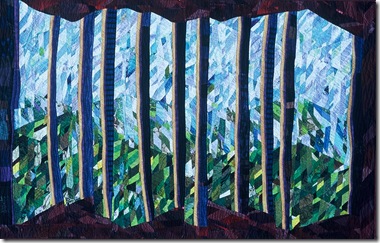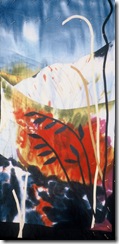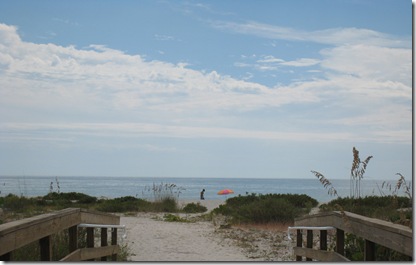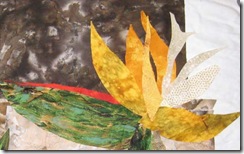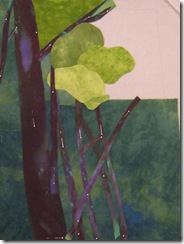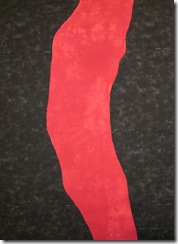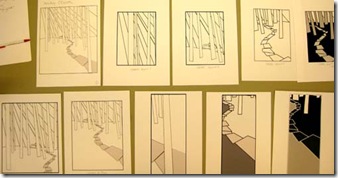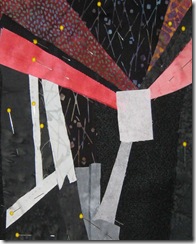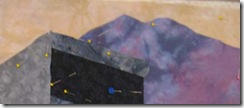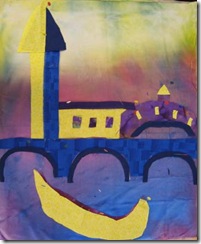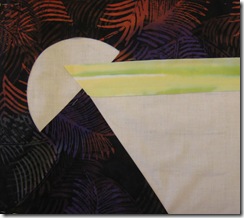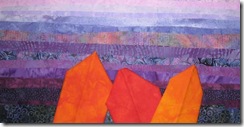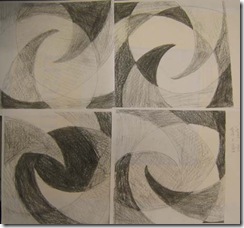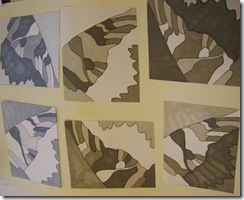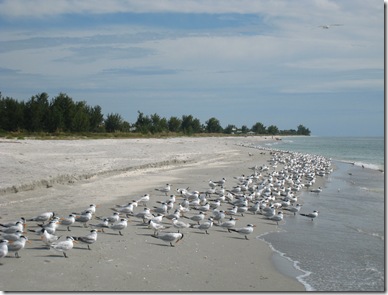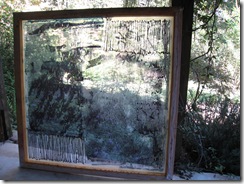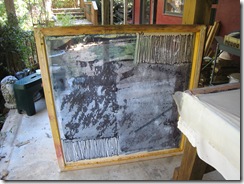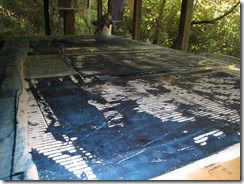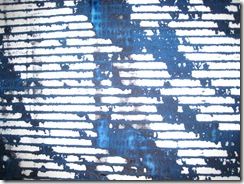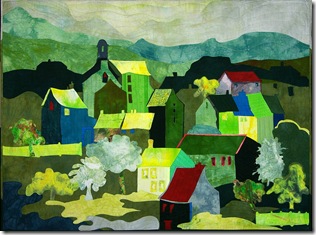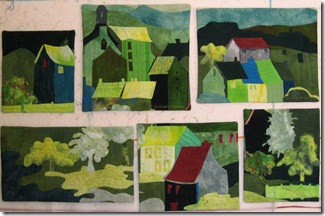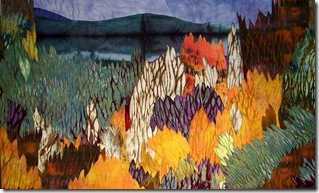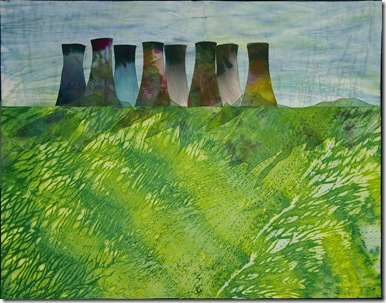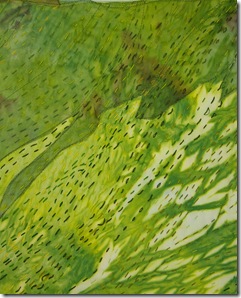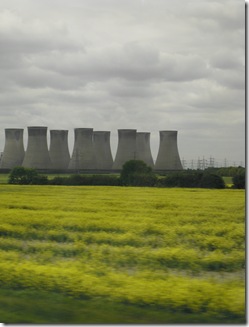I went down to the university art department last week again to hear a talk given by this month’s visiting artist. Sadly, it was a much quieter student group with no interesting tattoos (or other things!) to ogle! BUT, no matter ! I’m so thrilled that I can add to my art education by attending these talks; there is so much one can learn and be inspired by. Don Lipski is a sculptor who has completed many commissions in the 1% for art program. His use of “found” or “manufactured” objects is totally fascinating. He discovers beauty in shoelaces and rope and testtubes…don’t know whether I could incorporate some of those into my quilts…but…worth cogitation!

This butterfly hangs in Denver university in one of the science departments; it is made from test tubes filled with resin. The butterfly is suspended from one cable so that it moves gently – even though it weighs a tremendous amount.

This is a detail.
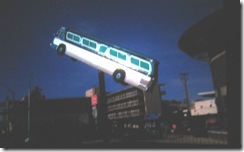
Sorry this isn’t a very good picture - Lipski took a bus, cut it in half longitudinally then took out a wedge (narrow at the front, wide at the back) had the bus reassembled and then mounted as a sculpture in front of a bus station. It is still fully wired, so all the lights come on at night. I was reminded of the special bus that Harry Potter rides on! This is in Reno, NV- an appropriate setting for magical beliefs!
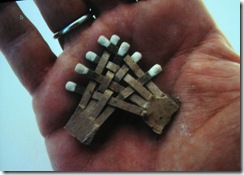
Lipski wasn’t originally an art student, he studied American History at the University of Wisconsin and having flunked a sculpture class, in his last year took a ceramics class instead. The teacher was so inspiring that he decided to go on to grad school to get an MFA. He had always made little sculptures – like the one made from matches on the right…and saved these until he was able to have a show with hundreds and hundreds of them. Always playing with found objects, thi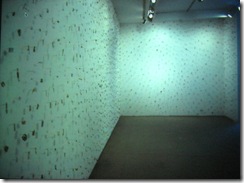 nking about what you might make….
nking about what you might make….
He pinned the little sculpture up on the wall (see left)and called the show “Gathering Dust”. What a perfect title! Something to think about……probably like you I’m keen to remove those dust gatherers! so where are the sculptors when you need them?!
He had always wanted to make Big Sculpture, however. When living in NYC (don’t all move to NYC by the way because this was in the “old days” when gentrification was just beginning and factories moving away from Manhattan would just dump all their inventory on the street) in Tribeca and with a huge empty factory for a studio he was able to bring home masses of stuff from dumpsters. One time he was able to “rescue” a whole dumpster full of brush handles and made sculpture from them. He was very amused to read one critic’s review of his obsessive removal of all the bristles! He’s very happy for people to read what they want into his pieces!
A typical piece made from of dumpster rescued material might be a walker (Zimmer frame) with a dead netted Christmas tree trapped inside it. He enjoys just making things, taking things and putting them together to make you rethink their shape and form. He formed fly swatters into an elegant wheel – and later books into a wheel form. (see lower down). .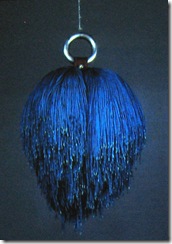
People would call and let him know when factories were going out of business; the piece on the right was made from thousands of discarded shoelaces.
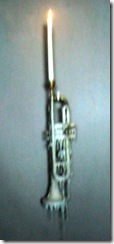
Candles were a great find! he loved to make unusual sconces for them – here the trumpet becomes the candle holder and the wax gradually drips over the trumpet. So – if your child won’t practice on his instrument..well…turn upside down and insert candle! Lipski stated he didn’t plan great metaphors for his work, he just put things together. People can derive their own metaphors he feels.
He’s done a lot of work with books: “maybe I’ll look smart and literary” he says as he nails books to a wall, or arranges them in piles from largest to smallest. That reminded me of the rector’s daughter in Cranford who felt that in inheriting her father’s library she developed a “literary” reputation!
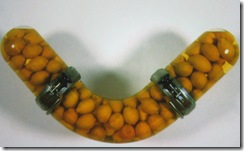
Lipski has had several artist residencies with big companies and has been able to use their manufacturing techniques to create strange and unusual objects. During one such residence at Corning Glass he was able to entrap many fruits, flowers, vegetables within glass as above.
When he goes to a factory, he like to ask “What if I ….” about the objects he finds there. This question was the most important one students should be asking he felt, that their main job is “to learn to believe in experimenting, in going off in every direction”.
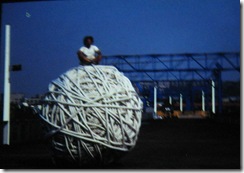
Here a helper sits atop a giant ball of “string” – heavy duty marine rope at Gateshead in England. It took a dozen people and a fork lift to roll up this ball! Sadly, when the powers at Gateshead returned the piece to the artist, they unrolled it in order to ship him the rope!!! I’m so glad that doesn’t happen to other art forms…imagine getting back a few yards of fabric and thread rolled onto a spool when your piece was returned from the show!
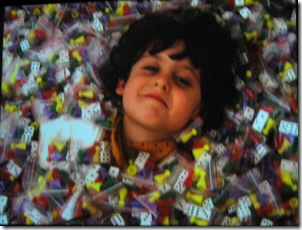
One time Lipski was given a million little plastic bags with dice inside – part of a failed game someone had developed. He took the dice out, but couldn’t think of anything to do with the plastic bags but found they made great photos when he got his son to leap into the pile and pose!
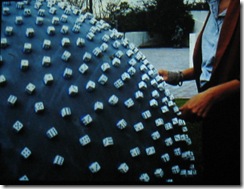
Some of the dice were glued onto a giant metal buoy he was given….
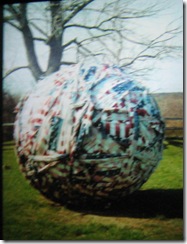
He worked with the Fabric Workshop in Philadelphia making things out of flags in response to the anti-flag burning legislation that was proposed. In a show“Who’s afraid of Red White and Blue?” at the Corcoran, he included a giant ball covered with tied flags.
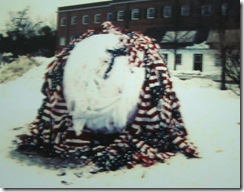
After the show the ball went to a college sculpture garden, but was vandalized – the flags cut off and ripped apart by protestors: a ball covered with faded, twisted flags was unAmerican they felt. As in “kill the abortionist for he kills”. Why don’t they look in the mirror?
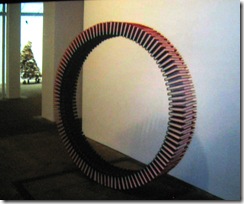
Now he’s doing interesting things with books! Here is a wheel of books, but he has also covered who walls with books splatted out and nailed down! There are a number of massmarket books I’d be happy to do that to!

There are few things he doesn’t work with – when trying to give up cigarettes, he decided to make sculptures from all the cigarettes he might have smoked – this is one of several pieces where the cigs are arranged in large humidors, placed filter side out, or tobacco side out to give two different values.
When working in San Francisco he couldn’t find anything to make art from unlike NYC and Houston. But he did come across a razor blade factory – and so made a piece from them – a chilling room with the walls entirely studded with razor blades jabbed into the plaster on one corner. No problem generating metaphors there.
Now he lives on Long Island and there’s no manufacturing, no choice dumpsters filled with goodies! but there is sand and wood…so that is what he uses. He made a piece for Grand Central Station that was composed from an old dead olive trees, suspended upside down with chandelier crystals attached to every branch. In Denver he made sculptures from the city workers tools – bolted together into wild arrangements. He made a sculpture from cowboy hats – in order to collect enough hats he hosted a great party, but you had to bring a hat to get in! “I can make art out of anything in the world…I’m now making something from plastic skeletons!”.
Actually…..he confessed he sits at a computer all day dreaming up these ideas on Photoshop and has a project manager who actually realises these seemingly impossible ideas – like a fountain made from bathtubs overflowing! (though for that he bought doll house bathtubs and glued them together for the maquette!). For once, Photoshop was not up to his dreams!
And so…see you down at the Dumpster! If you have been, thanks for reading, Elizabeth
PS I’m off to Florida to give a workshop on Working in a Series; I’ll be back in a week with pictures from there – I hope! – of amazing things!
